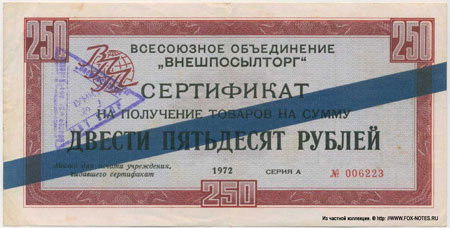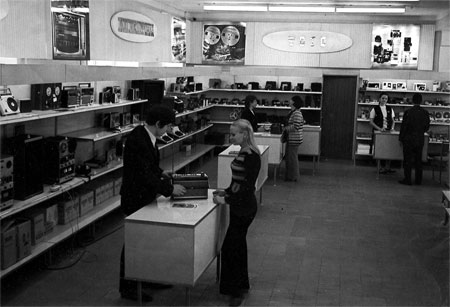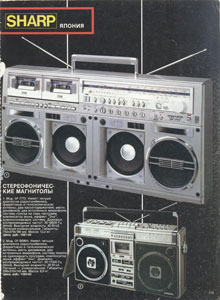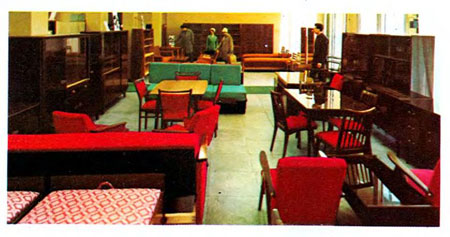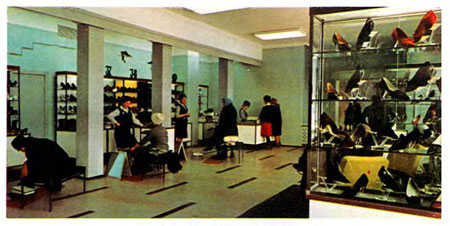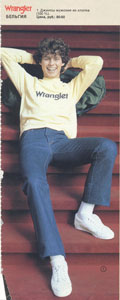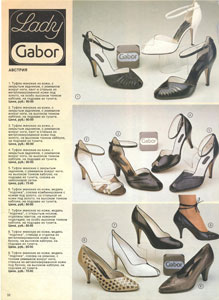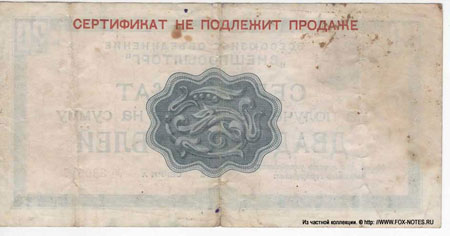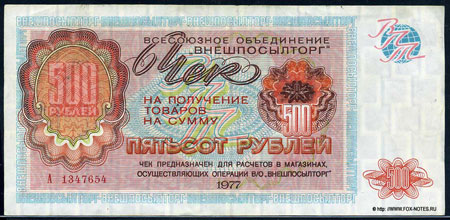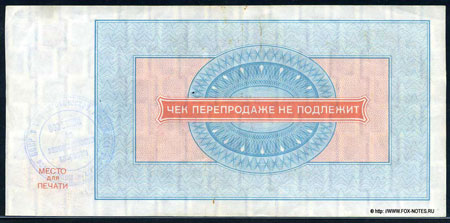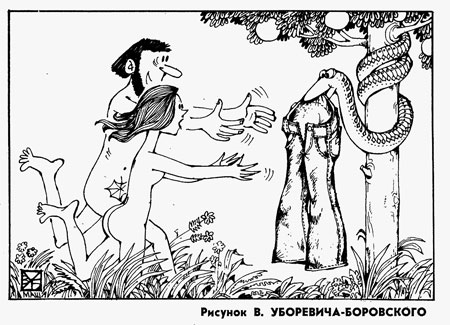1. The origins of Beriozka stores
In the autumn of 1969, the Soviet dissident Andrei Amal’rik published an essay entitled ‘Will the Soviet Union Survive Until 1984?’ in the British journal Survey. At that time, Amal’rik was actively involved in ‘anti-Soviet activities’. He informed foreign correspondents in Moscow about acts of political repression in the Soviet Union and had previously spent a year in exile in Siberia. His manuscript was smuggled abroad secretly. However, when the British journal sent a remittance in his name as a fee for his publication, Amal’rik was able to receive this money officially via a Soviet bank. Moreover, he received his fee in the form of special ‘certificates’, which served as substitutes for foreign currency, and which could be spent in a special store called Beriozka, where the most sought-after consumer goods were on sale, inaccessible to ordinary Soviet citizens.1 This story challenges the common assumption that privileged consumption in the Soviet Union was limited to people who were loyal to the regime. In this article I will explore the paradoxical phenomenon of Beriozka stores, which existed in the USSR from the late 1950s to the late 1980s, and show how these stores influenced the social hierarchy of Soviet society.
In the second half of the 1950s, the Soviet Union became much more open to the outside world. It participated in international projects, opened new embassies, trade missions and news offices abroad, and provided ‘technical assistance’ to postcolonial countries. As a result, a large number of Soviet citizens worked abroad and their wages were paid in foreign currencies. In the same period, a growing number of foreigners visited the USSR for business or tourism and also brought with them foreign cash. Since the Soviet Union was in need of foreign currency in order to pay for imported equipment and consumer goods, and since many goods in the USSR were in short supply, the government decided to offer Soviet citizens and foreign visitors the possibility to pay in foreign currency for certain scarce goods which were not available in ordinary Soviet stores, or which were available only occasionally and after extensive queuing.
Beriozka were not the first Soviet stores to trade in foreign currency. A generation earlier, the USSR had already briefly established Torgsin (an abbreviation for torgovlia s inostrantsami, trade with foreigners), a chain of state-run retail stores for foreign currency and precious metals. Torgsin existed from 1931 to 1936 and allowed people to trade in jewellery and other valuables they owned. The state used the money and valuables obtained in this way to finance industrialization. Since Torgsin mostly sold food during the famine, shopping in Torgsin stores became a matter of survival for many Soviet citizens.2
2![]()
The ‘second birth’ of retail trade for foreign currency at the end of the 1950s took place in completely different circumstances. It no longer served starving people who took their family jewellery to Torgsin stores, but rather well-to-do Soviet citizens who worked abroad and received their salaries in foreign currencies. According to a secret decree of the Council of Ministers of the USSR, in 1958 Soviet officials working abroad were granted the opportunity to open foreign currency accounts at the Bank for Foreign Trade of the USSR (Vneshtorgbank) and to pay for consumer goods in the form of bank transfers.3 On their return back home, they could pick up the goods they had paid for in special stores. In 1958 there were nineteen such stores across the country, and in 1960 there were already seventy-three of them.4 In 1961, Vneshposyltorg, a special organization responsible for trade in foreign currency in the USSR, was created within the Ministry of Foreign Trade.5
At the same time, in 1961, foreign tourists were also allowed to pay with foreign currency for the souvenirs they bought in the USSR. But unlike Soviet citizens, they paid in real cash. Special stores for foreigners were opened in airports, hotels and tourist sites, whose purpose (as in the case of trade via Vneshposyltorg for Soviet citizens) was to amass as much currency as possible.6 These were the first stores to be called Beriozka.7 Later on, the term was also applied to the whole system of trade in foreign currency in the USSR. By that time, the word Beriozka (birch tree) had already become associated with the image of the USSR abroad. In 1930, a district of Magnitogorsk where western engineers lived was called Beriozki,8 and in 1948 a folk dance group called Beriozka was created, which often performed abroad. In other republics of the USSR, stores for foreign tourists had other names. In Ukraine Kashtan (chestnut) and in Latvia Dzintars (amber) stores appeared at the same time as Beriozka stores. However, the brand name Beriozka soon became generic: the name originally used only for the stores that served foreigners in the RSFSR came to be applied to the stores that sold goods to Soviet citizens via Vneshposyltorg all over the USSR.
Vneshposyltorg certificate with a blue stripe (equivalent to the currencies of Socialist countries), 1972
(private collection, http://www.fox-notes.ru)
Since Soviet citizens were not allowed to pay with foreign cash, and bank transfers were very inconvenient, special vouchers called Vneshposyltorg certificates, sertifikaty, denominated in roubles, were introduced in 1965 as a form of payment for goods in Vneshposyltorg Beriozka.9 On Vneshposyltorg’s orders, the State Bank of the USSR issued certificates in denominations of 1, 3, 5, 10, 20, 50, 100 and 250 roubles as well as 1, 2, 5, 10, 25 and 50 kopecks. Salaries paid in foreign currencies and not spent abroad were converted to roubles, and the person could finally get hold of his or her earnings in the USSR in the form of certificates. Initially, there were three different types of certificates, depending on the original currency in which the person was paid his or her salary (currencies of socialist countries were converted into certificates with a blue stripe, currencies of developing countries into certificates with a yellow stripe, and those of capitalist countries into stripeless certificates). Different types of certificates had different purchasing power; moreover, depending on the type of certificate one possessed, one was entitled to buy a different selection of goods (stripeless certificates were the most valuable, certificates with a blue stripe the least). In 1977, however, ‘striped’ certificates were abolished and a single type of currency substitute was introduced. The so called Vneshposyltorg checks (cheki) were now used as a substitute for any currency.10 In 1967, Soviet employees working abroad spent about 40 per cent of their salaries to purchase foreign currency substitutes.11
3![]()
Around the same time, similar kinds of stores were established in other East European countries: Intershop in the GDR, Tuzex in Czechoslovakia, Corecom in Bulgaria and Pewex in Poland. Their main rationale, as in the Soviet Union, was for their respective governments to accumulate as much hard currency as possible. However, in contrast to the Soviet Union, trade in Central and South-eastern European countries with foreigners for foreign cash and with their own citizens for currency substitutes took place in the same stores.12
One of the first items offered to Soviet citizens for foreign currency was a car – a rare item of private property in the USSR and a Soviet consumer dream.13 An ordinary Soviet citizen could buy a car only by registering on the waiting list at his or her workplace. The waiting period varied depending on the particular place of work, on the person’s position and his or her personal connections, but in most cases it took several years. However, there were different ways in which one could skip the queue. For instance, high-ranking officials were entitled to privileged consumption which enabled them to buy cars, or one could buy a car on the black market (but that could be rather dangerous). In these circumstances, the possibility of buying a car for foreign currency via Vneshposyltorg without any queue was very attractive. In 1970 Vneshposyltorg sold about 8,000 cars for foreign currency in Moscow.14 The total number of vehicles sold to individuals in the USSR in 1970 for ‘normal’ roubles was 123,000,15 which means that only the Moscow branch of Vneshposyltorg sold as much as 7 per cent of all cars sold in the USSR. Unlike Central and South-eastern European countries, where foreign cars could also be bought for foreign currency,16 in Vneshposyltorg only domestically manufactured cars were available.
As early as 1958, durable items such as refrigerators, television sets, washing machines, tape recorders, cameras, radios and vacuum cleaners were also available for foreign currency.17 In the Soviet Union, production and consumption of household and electronic appliances was considered to be an important part of the plan to raise citizens’ living standards, as well as an element in the competition with the capitalist West.18 During this time, the demand for home appliances increased because since the late 1950s, more and more people were moving from communal to individual apartments and were eager to furnish the first private kitchens of their lives. Initially only Soviet-manufactured appliances were on sale for foreign currency, but in 1965, Vneshposyltorg also began providing imported durables, of which those made in the West were in highest demand. Even today, former Beriozka customers recall the high quality and durability of these commodities and emphasize their European origin: ‘In 1979 a friend of mine bought in Beriozka in Moscow a Grundig radio, produced in West Germany, it still works flawlessly!’19 In the early 1980s, Beriozka shoppers could also buy Japanese audio and video electronics. In the late USSR, these items were valued as highly as cars. The wife of a Soviet television correspondent who worked in Egypt in the 1970s recalls that, ‘We bought a Sharp tape recorder, it was the coolest thing back then, it could record from the radio. But my daughter and her husband were so anxious to buy a car, and she asked, “Could you give us this Sharp?” – Well, I gave it to her, they sold it and bought a Zaporozhets car.’20
4![]()
Another amazing opportunity offered by Vneshposyltorg was the chance to get cooperative apartments.21 This form of housing, which usually implied joint construction and joint ownership of an apartment building, was another key material value in the USSR. Cooperative apartment building first began in 1958 and became widespread during the 1960s.22 For citizens waiting in line for many years to be granted free housing by the state, joining a cooperative was the only way to improve their housing conditions – for example to no longer have to share small living quarters with relatives they did not get along with. People could organize a cooperative at their workplace, but even to join a cooperative one had to register on a waiting list because housing was in very high demand. An alternative way to buy a cooperative apartment without any queue was to pay for it in foreign currency, which became possible in 1965.23
Later, the choice of Beriozka goods was expanded to include furniture, clothes, shoes and even food.24 Imported clothing and footwear were highly valued in the Soviet Union because of the crisis of Soviet light industry. In ‘ordinary’ Soviet retail stores, one occasionally encountered commodities imported from socialist countries, while Western-made goods were firmly associated with Beriozka. A Beriozka customer recalls that, ‘Yes, you could buy Hungarian, East German, Czech shoes, furniture and clothing, for us even that was a big deal, but first you had to come across it and then stand in a monstrous queue, while in Beriozka you could buy everything you wanted, even goods from “real” countries – without any queue.’25
In 1965, Vneshposyltorg had more than a hundred stores selling goods for foreign currency substitutes in thirty-three cities across the Soviet Union. The stores were generally in the capitals of the Soviet republics as well as in major cities of the RSFSR and Ukraine.26 It is rather difficult to estimate the total turnover of this kind of trade across the Soviet Union.27 However, we can say that it was constantly growing: while in 1965 the equity capital of Vneshposyltorg was one million roubles, in 1979 it was already five million.28 The available statistics on the Moscow Beriozka tell us, for example, that in 1970 car sales accounted for 50 per cent of their revenues, clothing for 20 per cent, perfume and cosmetics 6 per cent, home appliances 3.2 per cent, food 5.3 per cent. The rest consisted of accessories – handbags, umbrellas and similar products. 75 per cent of all goods on sale in the Moscow Beriozka were imported. The remainder consisted of Soviet production designed for export (which was of better quality than goods designed for the domestic market).29 The turnover of Moscow Vneshposyltorg stores in 1978 was 257.6 million roubles (a profit of 5.6 million), in 1979 – 274.4 million (a profit of 8 million), in 1984 – 325.6 million (a profit of 13.6 million).30
5![]()
2.1. The first category of Beriozka customers, as mentioned, were citizens of the Soviet Union who earned money abroad. Some of them held positions in Soviet organizations abroad, that is, as employees of embassies, trade missions, and as newspaper or television correspondents. Others were representatives of the Soviet Union in international organizations such as the UN, UNESCO, IAEA, etc.
In Soviet society, an overseas job was seen as a highly desired opportunity and a way of improving one’s family’s material welfare back home: abroad, one could buy goods that were not available in Soviet stores, either for one’s own consumption or for a profitable resale, or both. But one could also save the money to exchange it later for Vneshposyltorg certificates and buy goods that were scarce in the USSR. A Soviet banker recalls his experience in London: ‘[…] life there was comfortable enough, we could buy good food and clothes. And, of course, like any other “comrade” sent abroad no matter on what position, by the end of my three years’ term I wanted to save Vneshposyltorg checks to buy a car and some other nice things from Beriozka...’31
Among people who earned money abroad were also Soviet specialists working in postcolonial countries in Asia and Africa in the framework of ‘economic and technological cooperation’ agreements in the Soviet sphere of interest. These specialists built industrial facilities, trained local engineers or contributed towards the development of local cultural and health care institutions.32 Since their work was part of a long-term loan provided by the Soviet Union to ‘Third World’ countries, the Soviet specialists’ wages were paid in foreign currency. In the period from 1955 to 1961, the overall amount of Soviet aid to developing countries increased from three million roubles to 2.5 billion roubles (both converted to post-1961 reform roubles).33
6![]()
To obtain a diplomatic position abroad, one had to meet many (mainly ideological) requirements while getting a job in a ‘Third World’ country was usually not a problem; almost any Soviet specialist could do so. The sociologist Georgi Derluguian recalls that in 1984, while still a student, he worked in Mozambique for a year as an interpreter, and afterwards ‘could buy a Volga car and there would still remain plenty of checks to buy presents in Beriozka for the whole family’.34 A son of a Soviet engineer who worked in Algeria remembers that, ‘After returning from Africa, our family of six and other relatives for over ten years didn’t know what shortages were. We lived in a small town in Uzbekistan, we went to Beriozka in Tashkent and bought there everything from a Volga car to clothes and shoes.’35 One of my respondents recalls that after graduating from the Department of Foreign Languages of Kharkov State University in 1979, he was appointed as an interpreter to Angola, where a group of Soviet military specialists was training the ‘liberation army’ of Namibia.36 After returning home, the interpreter bought an apartment in Kharkov, and after his second business trip to Angola in 1986, this time as a civilian translator, he bought another one.37
Indeed, the opportunity to shop in Beriozka in the future often became an incentive to work in Asian and African countries. A Moscow engineer explained to me that he went to work in Africa so that he would be able to buy a car without a waiting period: ‘Only five or six cars were allocated annually for the employees of a big academic institute where I worked. It was clear that I wouldn’t get a chance to buy one in the coming years. So when I was invited to go to Libya for a year, I agreed immediately. I understood that when I came back, I would buy not only a Lada, but perhaps even a Volga without any queue.’38 In 1988, when the circulation of Vneshposyltorg vouchers was terminated, an official responsible for sending Soviet specialists to postcolonial countries said in an interview: ‘[…] the prestige of a job abroad immediately declined. [...] It turned out that what kept people there was clothing and footwear from Beriozka.’39
A third group of Soviet citizens who could legally earn foreign currency consisted of those who travelled abroad for business purposes for short periods of time. They could be sent on a short-term assignment by any Soviet institution, or they could be cultural figures or athletes attending cultural or sports events.40 People from this group received per diem allowances from the state or were paid by the inviting party. Iren Andreeva, who from the 1960s worked as a fashion designer for the Soviet light industry, wrote in her memoir that her first business trip abroad was to Bulgaria. She was given her per diem in Bulgarian currency, and was advised by friends not to spend this money during the trip, ‘because even Bulgarian levs could be exchanged for Beriozka certificates, and in these stores you could find goods much better than in Bulgaria’.41
7![]()
Also Soviet artists who enjoyed popularity in the West went on foreign tours and shopped in Beriozka afterwards. Among them were even some who were not quite loyal to the Soviet regime. Artists such as the cellist Mstislav Rostropovich and his wife, the opera singer Galina Vishnevskaia, travelled abroad frequently, even though they supported people most hated by the regime, in particular Aleksandr Solzhenitsyn.42
Another group who went abroad on government missions was Soviet military personnel. However, those who served in the Soviet forces in Eastern Europe had no right to exchange their foreign currency salaries for Vneshposyltorg checks. There were only few exceptions: lieutenant colonel Vladislav Suntsev, who served in the Group of Soviet Forces in the GDR and was sent from there to Czechoslovakia to suppress the ‘Prague Spring’, remembers that during that operation the officers were paid their per diem in Vneshposyltorg certificates.43 Those who took part in the Soviet war in Afghanistan (1979–1989) were formally part of Turkestan military district (located on Soviet territory), and therefore were not required to be paid in Afghan currency, but instead received their salaries in Vneshposyltorg checks, which they could use in the stores located on their military bases, but also in Beriozka stores when they were back in the USSR.44
2.2. Soviet citizens who did not go abroad, but received remittances from foreign sources also had the right to shop in Beriozka stores. These remittances might be author’s royalties (for example if his or her book was published abroad), but also money sent by foreign relatives or friends, including inheritance or alimony. The state could decide who was or was not allowed to travel abroad, but it could not regulate who received remittances. What is more, the government had a vested interest in remittances being sent to Soviet citizens: since the recipients would get only the substitutes, the foreign currency would be accumulated in state coffers. But the recipients could often be ‘unreliable’ citizens, as they had connections with foreigners by definition.
8![]()
For a long time, the receipt of royalties from abroad remained unregulated, and the government treated such payments simply as remittances. Andrei Sakharov wrote in his memoirs: ‘The Saturday Review had asked a number of prominent figures to contribute articles for a special anniversary issue on “The World in Fifty Years”. […] I worked hard on the article and I certainly earned my compensation: five hundred dollars, my first hard-currency earnings. At that time it was still possible to receive money from abroad in the form of “Beriozka” certificates accepted at special hard-currency stores, and we used my fee to buy canned meat and other food products to send to prisoners in the camps.’45
In 1974, Aleksandr Solzhenitsyn, after his expulsion from the Soviet Union, used his royalties for The Gulag Archipelago to establish a fund for political prisoners and their families. The widow of Aleksandr Ginzburg, the first head of the fund in the Soviet Union, remembers that the remittances were sent from abroad as a gift to her husband; he received them in the form of Vneshposyltorg certificates, bought in Beriozka a variety of goods that were mostly unavailable in regular Soviet stores, and passed them on to prisoners and their families.46
However, in 1973 new rules regulating the receipt of royalties were introduced. An All-Union Copyright Agency (VAAP) was established, and all those who published something abroad had to sign a contract with VAAP. After that, the royalties earned abroad had to be sent via VAAP, which kept the foreign currency and issued Vneshposyltorg certificates to the authors.47 In 1976, another restriction was introduced: remittances sent to individuals (as opposed to organizations such as VAAP) could no longer be exchanged for certificates. Recipients were only entitled to receive the equivalent in roubles minus a 30 per cent commission charged by the state.48 Sergei Khodorovich, another former head of the Solzhenitsyn fund, believes that this measure was part of the KGB struggle against the aid to political prisoners.49
9![]()
Now, the opportunity to exchange the royalties for publication abroad for currency substitutes was limited to the writers or their heirs, who signed formal contracts with VAAP. As in the case of oppositional Soviet artists, the state benefitted from the publications of Russian writers abroad, for they provided financial gains and potentially improved the image of the USSR. But those same writers were not infrequently banned at home for political reasons. For example, Boris Pasternak’s son received through VAAP payments for the foreign publications of Doctor Zhivago, for which the writer had been persecuted in the USSR.50 In a similar manner, the widows of Mikhail Bulgakov and Osip Mandel’shtam officially received Vneshposyltorg checks.51
Not only authors’ heirs, but also contemporary Soviet writers had access to Beriozka. The Strugatsky brothers, who were extremely popular in the USSR, were approved by the authorities in the 1960s, but later fell from favour. They recalled that at that time their overseas publications and the checks they received for them were a real salvation: before that, they did not know how to survive, but after signing a contract with VAAP they could even buy a couple of cars.52
Another large group that received royalties from abroad were authors and translators of academic articles. In the second half of the 1970s VAAP signed several agreements with U.S. publishers, which enabled the publication of articles from Soviet academic journals in the United States. The Soviet side insisted that the articles in question had to be translated by Soviet translators. About 200,000 scholars and translators received Vneshposyltorg checks from VAAP every year.53 As of 1978, checks were also paid as a reward to scientists whose technological inventions were sold abroad.54
10![]()
Besides VAAP and the Committee of Inventions, there was another organization through which one could legally obtain Vneshposyltorg checks: Iniurkollegia, an agency in charge of the legal affairs of Soviet citizens abroad. An inheritance from abroad, for example, could be received only through this organization. Its clients in the USSR were relatives of Russian aristocrats who had fled the country after the October Revolution, or of Soviet soldiers who had chosen not to return to the USSR after the World War II and had instead settled in the West. For example, a Soviet citizen who used to live in a small town about four hundred kilometres from Sverdlovsk, remained in West Germany after 1945, made a fortune, and then got in touch with his daughter whom he had left behind in the USSR and began to send remittances to her. After his death, his daughter inherited his estate and was able to buy via Vneshposyltorg three cars as gifts for each of her three children.55
In most cases such remittances were sent to the Soviet citizens who lived in those regions annexed by the Soviet Union during the war – the Baltics, Western Ukraine, Belarus and Moldova.56 There were also unusual stories. In 1970, the dean of a Lithuanian cathedral received Vneshposyltorg certificates as payment of the inheritance bequeathed to the cathedral by a rich Lithuanian who had emigrated to the United States. Since the formal heir was not the dean, but the cathedral, certificates should not have been paid, but the Council of Ministers of the USSR sent an inquiry to the Representative of the Council for Religious Affairs in Lithuania. Its response was that ‘a refusal to pay the certificates will provoke a negative reaction in the Lithuanian community abroad, and we will be barred from receiving the inherited money in similar cases’.57
2.3. In addition to the groups mentioned above, there were also illegal Beriozka customers. One could buy Vneshposyltorg certificates and checks for roubles on the black market.58 The currency substitutes did not bear the name of the legal owner, and Beriozka salespeople almost never asked customers to show the documents confirming their right to possess the vouchers. To enter a Beriozka store, a person only had to prove that he or she indeed carried some checks. An informant from Leningrad recalls: ‘Women would buy one check for one rouble as a “pass” to get inside and just take a look, probably to try something on.’59
11![]()
Reverse side of the Vneshposyltorg certificate bearing the inscription ‘not for sale', 1972
(private collection, http://www.fox-notes.ru)
Vneshposyltorgcheck, 1977
(private collection, http://www.fox-notes.ru)
Reverse side of the Vneshposyltorg check bearing the inscription 'not for resale', 1977
(private collection, http://www.fox-notes.ru)
The emergence of the illegal exchange of the currency substitutes was reflected even in their appearance: in 1967, two years after the introduction of certificates in circulation, they were stamped with the words ‘certificate may not be sold’. As of 1972, this inscription was printed on all certificates.60 The Prosecutor’s Office of the USSR reported to the Council of Ministers that from 1970 to 1975, ‘there [has been] an increase in recurrent illegal operations with Vneshposyltorg certificates’.61 But the government did not take any active measures to stop the illegal exchange of foreign currency substitutes. In 1976, it was decided that such activities should be considered small-time profiteering (melkaia spekuliatsia), and therefore should not be punished too harshly – illegal operations with foreign currency in cash, however, were considered a serious crime and could even be considered a capital offense.62
Among illegal Beriozka customers there were those who had received vouchers from their relatives or friends and those who bought a certain amount through intermediaries for a concrete purchase, such as a pair of blue jeans, a fashionable blouse or nice gifts for friends. Vneshposyltorg checks themselves were considered a good present. In the words of a character from the Soviet novel Khromaia sud’ba: ‘I wondered what to give to Sonechka as a present? I’m not very good at making gifts. Especially to women. Maybe cognac? That’s no good, even if she loves a good cognac. Perfume? Have no idea how to choose it. Maybe I could just give her fifty roubles in Vneshposyltorg checks? A bit embarrassing.’63
Among those who bought checks for roubles there were even Vneshposyltorg employees. Despite the fact that every day they dealt with the purchase, transportation and sale of valuable goods, they did not have the right to buy them and could only envy the legitimate owners of the checks.64 Even high-ranking Soviet officials bought Vneshposyltorg checks – especially those who were not entitled to foreign trips but still wanted to buy Western goods, which were mostly unavailable – sometimes even in the special closed stores for the nomenklatura. One informant says that his mother-in-law often went abroad as a functionary of the Central Committee of the Communist Party responsible for the relations with foreign communist parties. Once her colleague from the Central Committee who was in charge of the electronics industry turned to her with an offer: he said that he could take as many television sets at the plant as he wanted, and suggested that he would take a couple for her if in exchange she would buy him a VCR in Beriozka, since he could not obtain it otherwise.65 A former Vneshposyltorg employee believes that the only reason the checks did not bear the name of the legal owner was so that high-ranking officials who did not travel abroad could buy scarce goods in Beriozka stores.66
12![]()
Another group of illegal Beriozka shoppers were wealthy Soviet citizens who earned their money illicitly, i.e. through underground enterprises. In a Literaturnaia Gazeta article published in July 1981, they were called ‘underground millionaires’.67 In the economy of shortages, buying checks for roubles was a way for them to turn their savings into real goods. One informant spoke about a friend of his who was the director of an ordinary Soviet store and accumulated a lot of money by selling goods under the counter. But he could not buy high-quality home appliances since they were always in short supply. So he bought checks from his friend and used them to purchase an otherwise unattainable Finnish Rosenlew refrigerator in Beriozka.68 A member of the famous rock band Mashina vremeni remembers that in the late 1970s, they earned a lot of money with underground concerts: ‘We received enough money to buy everything we wanted, but in those times you could not just go to a store and buy something, it was just impossible to find anything worthwhile. So we were in contact with the black marketeers and bought so-called Vneshposyltorg checks to be able to buy goods at Beriozka stores.’69
3. The social role and public perception of Beriozka stores
For those who received checks officially as well as for those who bought them illegally for roubles, and even for those who never held checks in their hands, Beriozka stores were a place of attraction. One witness recalls: ‘My friend’s mom used to go into Beriozka with a notepad and sketch all of the different clothes. She would then go home and use the drawings to make clothes for my friend. It was so great!’70
Apartments, cars, home appliances and furniture were expensive in Beriozka, so only those officials who had worked abroad for a long time or big-time black market dealers could afford them. For the majority of consumers, however, the most attractive Beriozka items were clothing, shoes and various accessories imported from the West. Based on her interviews on consumption in Soviet society with residents of Iaroslavl, researcher Anna Tikhomirova argues that clothing from Beriozka had ‘the highest distinctive importance for all surveyed Iaroslavl women’.71 A particularly important item was blue jeans: their appeal for people in the Soviet Union in the 1970s and 1980s was even reflected in the Soviet press. For example, a cartoon published in Krokodil magazine shows a young man announcing to his elderly mother: ‘Either Super Rifle jeans or I go on a hunger strike.’72
13![]()
Informants recall that fashionable clothes could be bought on the black market as well, but shopping in Beriozka had its advantages: you had the opportunity to try on the items, you could be sure of the authenticity of the brand, and it was easier to find non-standard sizes.73 Clothing from Beriozka was perceived as a perfect model. An Austrian scholar of contemporary Russian fashion, Katharina Klingseis, quotes an interview with a woman who possessed Beriozka checks: ‘She [her sister-in-law, who worked abroad] did not give us foreign currency but some slips of paper, I forgot the name, equalling a certain amount of money, and I went to the foreign currency shop and bought […] myself a beige dress, woollen material, made in France. Two pockets, one here and one there, silk lining, a belt of metal rings. When I appeared at the institute in this, they just gasped, ah, oh! It was obvious that the dress was imported, expensive, and it was just what you want.’74
Informants also recall that Beriozka was very special due to its atmosphere, which amazed Soviet consumers: ‘My first trip to Beriozka made a strong impression on me: everything looked so good, so necessary, so nice. And then there was the store’s atmosphere: there was nobody around, and the salespeople were so much more polite than usual – it was a completely different form of customer service.’75 However, the image of Vneshposyltorg stores in Soviet society was ambivalent. On the one hand, they were objects of attraction, places where the most desired Western goods were readily available. But on the other hand, they caused indignation because formally they were closed to the public, and not everyone could get inside. Some criticized Beriozka as a hotbed of privilege, comparing them to the raspredeliteli, special closed stores for Communist Party and state officials. Others, knowing that one could buy currency substitutes for roubles, complained that these stores were only for rich people.
Soviet historians Mikhail Geller and Aleksandr Nekrich, who emigrated to the West in the 1970s, wrote in 1986: ‘In the Beryozka stores the ruble has no value – a peculiar situation when a country will not accept its own currency.’76 People’s indignation about the fact that Beriozka did not accept Soviet money is also reported by an American journalist who lived in the USSR in the 1970s. He quotes his Russian interlocutor: ‘It is so humiliating, so insulting to have stores in our country where our own money is not valid.’77 This perception was also reflected in a short novel by the Soviet underground writer Iuz Aleshkovskii, first published in the United States in 1978. Sarcastically, he wrote that Beriozka stores ‘destroy people’s faith in our classless society’.78
14![]()
A Moscow respondent tells about her father who in the early 1980s received Vneshposyltorg checks for his translations into English of Soviet books on physics to be published abroad. She recalls a hostile attitude to Beriozka: ‘Well, our “Beriozka roubles” were not to be mentioned in our circle because those stores were considered a kind of closed store for big shots, and it was considered improper to have access to it even if it was gained in a fairly innocent way, not due to one’s Party or career status.’79 The Soviet writer Rimma Kazakova mentions in a poem from 1988 that when she shopped in Beriozka after receiving checks for the translation and publication of her poems abroad, she felt like a black sheep.80
People who shopped both in Beriozka stores and in raspredeliteli, however, noticed the difference in access to these two kinds of privileged shopping places. The son of an employee of the Soviet trade mission in the United States and the grandson of the Deputy Minister of the USSR recalls that access to the raspredeliteli was controlled much more strictly: his grandfather had special coupons to enter the raspredeliteli and never gave them to his grandson; they could only shop there together. Meanwhile his father, who had Vneshposyltorg checks, easily gave his checks to his son so that he could go to Beriozka by himself.81 Another respondent whose relative worked in the Central Committee of the Communist Party and also shopped in raspredeliteli said that nobody would ever get the idea of selling coupons to raspredeliteli to anybody: ‘One’s reputation in the Party mattered much more than money.’82
Other informants, mostly from outside of Moscow, tended to regard Beriozka stores not as places for top officials, but just as expensive stores. Getting in was not a problem, but to shop there one had to have a lot of money. A Samara resident recalls: ‘People went there to take a look, somebody bought checks and purchased something, but, honestly, I was far from doing it and looked at it with indifference: with my salary I couldn’t even think about it.’83 A respondent from Rostov-on-Don confirms: ‘When I was a school-girl, the expression “to purchase checks” was common, but neither I nor friends of mine ever did that, we didn’t have enough money.’84
15![]()
In broad public discourse, Beriozka stores were almost a taboo until the second half of the 1980s (in contrast with the situation in Central and South-eastern European countries where similar stores were openly discussed in the press85). The instruction by the Bank for Foreign Trade on how to exchange currency to Vneshposyltorg checks had to be kept in a special safe deposit box as a classified document.86 Beriozka was rarely mentioned in the press. One of the few hints that I could find was an article in the satirical magazine Krokodil in 1976. It tells about an illegal flea-market near Moscow, where a man sold an expensive sheepskin coat. A customer asked whether he could buy it a bit cheaper, and the seller answered that one could get it at a lower price only in Beriozka.87 The Krokodil piece did not explain what Beriozka was, so apparently it was assumed that readers knew it. Other mentions of Beriozka in the media were found in two articles exposing an American ‘spy’. In 1977, George Krimsky, an Associated Press reporter based in Moscow, was expelled from the USSR: Soviet newspapers reported that he persuaded Soviet citizens to share secret information with him and paid them with Beriozka checks.88 So, although Beriozka were legal Soviet stores, shopping there could sometimes be interpreted as bordering on treason.
With the beginning of perestroika, Beriozka emerged as a subject of discussions in the media. Those who criticized the existence of such stores insisted that, first, they were a government entitlement for the elite, and second, they contributed to the development of the shadow economy and illegal profiteering. Those who defended Beriozka said that they were not about privileges, but rather that shopping in Beriozka was a fair compensation for people who worked in hard conditions in postcolonial countries. As for the profiteering, they agreed that it was necessary to fight it.89 This discussion took place in the framework of two broader discussions that unfolded at the same time. One dealt with the problem of the privileges of members of the nomenklatura.90 The question was whether the ruling elite really enjoyed benefits unavailable to ordinary citizens, and if so, whether it had the right to do so – or if such privileges were undeserved and hidden from the public. In February 1986, Pravda for the first time published a letter from a reader who said that special closed-access hospitals, restaurants and stores for high officials should not exist.91 The same question was raised by Boris Yeltsin, then First Secretary of the Moscow Communist Party committee, at the Twenty-seventh Congress of the CPSU (also in 1986).92 The other discussion was about private entrepreneurship. Private enterprises, cooperatives, which were officially licensed in 1988, were presented by the Soviet ideology as a good thing, but the people were displeased by them.93 The problem of Beriozka stores fit well in both discussions: they were condemned because shopping there was seen as a privilege and because they generated dubious market activities. It would seem that the denunciation of officials’ privileges and the support of private initiative belonged to the same argument – the need to raise the efficiency of the Soviet socialism. In reality, however, people resented both, thriving officials and entrepreneurial businessmen – since the desire to differentiate oneself from others was deemed reprehensible.94
In January 1988, the Council of Ministers of the USSR announced its decision to stop the circulation of Vneshposyltorg checks and to close Beriozka in order to foster social justice.95 The defenders of Beriozka were disappointed and claimed that ‘the idea of “social justice” treats legal owners of checks almost as illegal businessmen’, ‘equates honest people and profiteers’, and the victims are those who ‘just modestly bought some necessary items which were not available in the stores’.96 In fact, this equation appears justified: by that time, ‘honest people’ and ‘profiteers’ who shopped in Beriozka indeed had a lot in common, and the concept of a ‘modest purchase of necessary items’ is a key distinction here.
16![]()
Public discussions surrounding Beriozka now unfolded under new circumstances, but were still framed in the old language and, more broadly, in the old mentality. Both parties agreed that Beriozka provoked profiteering, and the only point of dispute was whether access to these stores was a reprehensible privilege or a fair reward for hardship suffered for the sake of the country. However, terms such as ‘profiteering’ and ‘privileges’ failed to describe the complicated situation created by Vneshposyltorg stores during the thirty years of their existence. The range of legal Beriozka customers was constantly widening (they were no longer limited to ‘sufferers’ from postcolonial countries and high rank officials), and illegal exchange of the checks for roubles grew less risky (especially since 1976). A kind of Soviet middle class, people with a certain level of consumption, tried to find a way – legal or illegal – to get Vneshposyltorg checks to buy high-quality consumer goods. But it was these very same people, at the same time, who condemned the existence of Beriozka stores. In his book about the late USSR, anthropologist Alexei Yurchak mentions a similar ambiguity: people appreciated Western goods and bought them on the black market, but at the same time they thought that shopping on the black market was inappropriate, and those who sold those goods were immoral people.97
In the Beriozka debate, however, both sides missed the main point. These practices created a new social phenomenon: a consumer society in the socialist state. Beriozka became part of everyday life, an oasis of consumption in an atmosphere of chronic shortages, a place to shop for the Soviet middle class. Alongside high-level diplomats, Beriozka became a meeting point for those who worked in postcolonial countries, those who went on tours abroad or translated academic articles at home, those who had relatives overseas and those who illegally bought checks for roubles. These people were criticized (often by themselves) either for enjoying the state entitlement they did not deserve or for profiteering. However, they all simply wanted to buy fashionable goods, and their life decisions were determined by this desire.
It is commonly assumed in historiography that members of the nomenklatura were at the top of the social hierarchy in the USSR – the Communist Party functionaries and high-ranking officials.98 On the one hand, the Vneshposyltorg system corroborates this hierarchy. Soviet officials who worked abroad and earned foreign currency were carefully selected, and access to the coveted certificates was their reward for loyalty. But at the same time, Beriozka trade was in conflict with this hierarchy: among Vneshposyltorg customers there were also people who did not hold high positions and could even have been considered disloyal to the regime. Their main ‘merit’, paradoxically, was the possession of foreign currency.
17![]()
The opportunity to purchase through Vneshposyltorg the goods otherwise in short supply created certain consumer strategies and practices. For example, people went to work in postcolonial countries or translated academic books and articles into English specially to gain access to Beriozka. Access to these stores became a badge of belonging to the new elite, referred to by sociologist Boris Dubin as the ‘heroes of the epoch of the deficit which didn’t belong to the official ruling elite’.99 In the environment of chronic shortages, Beriozka became a source of high-quality goods: during the 1970s and 1980s, more and more people all over the Soviet Union got hold of the checks and regarded Beriozka as a consumer paradise. Beriozka created new opportunities for consumers who thought that it was just a state entitlement.
1 Andrei Amal’rik, Notes of a Revolutionary, New York 1982, pp. 86-91. I would like to thank the Gerda Henkel Foundation for supporting my research.
2 See Elena A. Osokina, Zoloto dlia industrializatsii. Torgsin [Gold for Industrialization. Torgsin], Moscow 2009.
3 RGAE (Rossiiskii Gosudarstvennyi Arkhiv Ekonomiki, Russian State Archive of the Economy), f. (fond) 7733, op. (opis) 49, d. (delo) 806, ll. (list) 106-112.
4 RGAE, f. 7733, op. 49, d. 806, ll. 11-13.
5 RGAE, f. 413, op. 13, d. 8893, ll. 223-230. Vneshposyltorg was an abbreviation for vneshniaia posylochnaia torgovlia, international mail order, since this organization could also send ordered commodities abroad to the country where the customer worked.
6 For the trade with foreigners, which I do not consider in this article, see J.L. Kerr, Hard-Currency Shops in Eastern Europe, October 1977, Radio Free Europe Research, RAD Background Report/211, 27 October 1977; Anna Ivanova, Istoria torgovoi seti ‘Beriozka’ v SSSR (konets 1950-kh – 1980-e gg.) [The History of the Beriozka Retail Chain in the USSR (late 1950s – 1980s)], in: Rossiiskaia istoria [Russian History] 5 (2012), pp. 172-185, here pp. 175-176.
7 GARF (Gosudarstvennyi Arkhiv Rossiiskoi Federatsii, State Archive of the Russian Federation), f. A-410, op. 1, d. 1570, l. 255.
8 John Scott, Behind the Urals. An American Worker in Russia’s City of Steel, Bloomington 1942, p. 86.
9 RGAE, f. 195, op. 1, d. 73, ll. 72-89. Foreigners stationed in the Soviet Union (diplomats, journalists etc.) were also entitled to shop in the Vneshposyltorg stores. For them, another type of voucher was introduced – checks of the Bank for Foreign Trade, series ‘D’ (RGAE, f. 7590, op. 17, d. 187, ll. 153-154).
10 GARF, f. 5446, op. 106, d. 1823, l. 219.
11 RGAE, f. 7733, op. 58, d. 86, l. 97.
12 On Tuzex, for example, see Paulina Bren, Tuzex and the Hustler. Living It Up in Czechoslovakia, in: Paulina Bren/Mary Neuburger (eds), Communism Unwrapped. Consumption in Cold War Eastern Europe, New York 2012, pp. 27-48. On Bulgaria, see Rossitza Guentcheva, Mobile Objects: CORECOM and the Selling of Western Goods in Socialist Bulgaria, in: Études Balkaniques 45 (2009) 1, pp. 3-28. In the GDR, only foreigners could shop in Intershops in the 1960s. GDR citizens were allowed access to these stores only in 1974. Initially they could pay with foreign cash, but in 1979 they were obliged to pay with ‘Forum-checks’. See Jonathan R. Zatlin, The Currency of Socialism. Money and Political Culture in East Germany, Cambridge 2007, pp. 243-285.
13 See Lewis H. Siegelbaum, Cars for Comrades. The Life of the Soviet Automobile, Ithaca 2008; Jukka Gronow/Sergei Zhuravliov, Soviet Luxuries from Champagne to Private Cars, in: David Crowley/Susan Reid (eds), Pleasures in Socialism. Leisure and Luxury in the Eastern Bloc, Evanston 2010, pp. 132-140.
14 GARF, f. 259, op. 46, d. 1924, l. 72.
15 Torgovlia SSSR. Statisticheskii sbornik [Trade in the USSR. Statistical Compendium], Moscow 1989, p. 158.
16 Bren, Tuzex and the Hustler (fn. 12), p. 29; Guentcheva, Mobile Objects (fn. 12), p. 9.
17 RGAE, f. 7733, op. 49, d. 806, ll. 106-112.
18 See Susan Reid, The Khrushchev Kitchen: Domesticating the Scientific-Technological Revolution, in: Journal of Contemporary History 40 (2005), pp. 289-316; Natalya Chernyshova, Consuming Technology in a Closed Society: Household Appliances in Soviet Urban Homes of the Brezhnev Era, in: Ab Imperio No. 2/2011, pp. 188-220.
19 Elena Riabikova, Podpol’shchiki sovetskoi ekonomiki [Undergrounders of the Soviet Economy], in: Sloboda (Tula newspaper), 17 May 2006.
20 Interview with V.V.D. (Moscow), 20 March 2009. Hereinafter, all interviews mentioned were conducted by me in several post-Soviet cities in 2009–2011. I conducted about thirty interviews with former customers of Beriozka stores and with several people who used to work there.
21 GARF, f. 5446, op. 106, d. 1437, ll. 270-272.
22 Donald D. Barry, Housing in the USSR. Cities and Towns, in: Problems of Communism 18 (1969) 3, pp. 1-11, here pp. 10-11.
23 In Bulgaria, one could buy not only apartments for foreign currency, but also houses and even plots of land; see Guentcheva, Mobile Objects (fn. 12), p. 8.
24 Food sales were abolished in 1976 (GARF, f. 5446, op. 106, d. 1823, l. 219) – apparently for ideological reasons, but no explanation for this decision can be found in the documents.
25 Interview with L.G.O. (Naberezhnye Chelny), 28 May 2011.
26 RGAE, f. 7733, op. 56, d. 2, ll. 303-305.
27 There is no separate archival fund of Vneshposyltorg. Fragmentary documents are stored in the collection of the Ministry of Foreign Trade (RGAE, f. 413). The trade with currency substitutes was also actively discussed at the sessions of the Commission of the Presidium of the USSR Council of Ministers for Foreign Economic Affairs, but these materials are classified.
28 RGAE, f. 413, op. 31, d. 522, ll. 224-228; d. 1, l. 14.
29 GARF, f. 259, op. 46, d. 1924, ll. 72-75.
30 GARF, f. A-410, op. 1, d. 3288, l. 211; d. 3416, l. 177; d. 4022, l. 159.
31 Nikolai Krotov, Zhizn’ i udivitel’nye prikliuchenia Viktora Gerashchenko, zapisannye Nikolaem Krotovym [Life and Amazing Adventures of the Banker Victor Gerashchenko, recorded by Nikolai Krotov], Moscow 2010, p. 533.
32 See David C. Engerman, The Second World’s Third World, in: Kritika 12 (2011), pp. 183-211.
33 RGANI (Rossiiskii Gosudarstvennyi Arkhiv Noveishei Istorii, Russian State Archive of Contemporary History), f. 5, op. 30, d. 371, l. 40.
34 Georgii Derluguian, Povest’ o dvukh gorodakh. Ot Moskvy do samogo Chikago: opyt samotsiologii domovladenia [From Moscow to Chicago: An Experience of Introspective Analysis of Real Estate Ownership], in: Logos No. 5/2005, pp. 89-130, here p. 91. (With some variations, these memoirs were published in English: Georgii Derluguian, A Tale of Two Cities [The Adventures in Globalization], in: New Left Review No. 3/2000, pp. 47-71.)
35 Discussion on Beriozka, 2011, URL: <http://dirty.ru/comments/323728>.
36 Interview with M.I. (Kharkov), 24 June 2010.
37 Formally speaking, each citizen working abroad could buy only one apartment, but through informal agreements with local authorities as well as marriages of convenience, people managed to acquire two flats and more.
38 Interview with I.L. (Moscow), 8 August 2011.
39 Nina Iakovchuk, Nazad k uravnilovke: reshili zakryt’ magaziny ‘Beriozka’ – a dal’she? [Back to income levelling: they decided to close Beriozka stores, but what next?], in: Ekonomicheskaia Gazeta [Economic Newspaper] No. 30/1988, pp. 18-20, here p. 18.
40 This group also included transport workers (on international flights, trains and ships). For sailors whose vessels sailed abroad a parallel chain of stores (called Al’batros) with another type of currency surrogates was organized. See Ivanova, Istoria torgovoi seti ‘Beriozka’ (fn. 6), p. 176.
41 Iren Andreeva, Chastnaia zhizn’ pri sotsializme. Otchiot sovetskogo obyvatelia [Private Life under Socialism. A Report by an Ordinary Soviet Citizen], Moscow 2009, p. 185.
42 See Galina Vishnevskaia, Galina, Moscow 2006, pp. 381-414.
43 Vladislav Suntsev, Operatsia ‘Dunai’: kak eto bylo [Operation ‘Danube’: How It Was], in: Voni zahischali mir u Evropi [They Defended Peace in Europe], Zhitomir 2003, pp. 24-41, here p. 40.
44 This was possible only until 1987. Afterwards, Soviet servicemen got special Vneshposyltorg checks and could spend them only on Soviet military bases in Afghanistan; see Aleksandr Ramazanov, Rodnaia afganskaia pyl’ [Dear Afghan Dust], Moscow 2010, p. 67.
45 Andrei D. Sakharov, Memoirs, London 1990, p. 410.
46 Arina Ginzburg, Aleksandr Ginzburg: ot ‘Sintaksisa’ k ‘Helsinskoi gruppe’ [Aleksandr Ginzburg: from ‘Sintaksis’ to ‘Helsinki Group’], in: Materialy k konferentsii ‘Pravedniki v GULAGe: tsennost’ moral’nogo soprotivlenia sovetskomu totalitarizmu’ [Righteous in the Gulag: Moral Resistance to Soviet Totalitarianism. Conference Materials], December 2003, Milan, Italy, URL: <http://www.gariwo.net/file/Original%20language%20reports.pdf>, pp. 33-40, here p. 38.
47 GARF, f. 5446, op. 1, d. 869, l. 42.
48 RGAE, f. 7590, op. 17, d. 450, l. 26.
49 Interview with Sergei Khodorovich, 8 June 2011.
50 Interview with Evgenii Borisovich Pasternak (Moscow), 20 October 2009.
51 Sergei Iurskii, Zapadnyi ekspress [Express to the West], in: Oktiabr’ [October] No. 5/1999, pp. 38-60, here p. 59; Lazar’ Lazarev, Ukhodiat, ukhodiat druzia… [My Friends Pass Away...], in: Znamia [Banner] No. 10/2008, pp. 157-172, here p. 170.
52 Interviu s bratiami Strugatskimi [Interview with the Strugatsky brothers], in: Ezhenedel’nyi zhurnal [Weekly Journal], 3 November 2003.
53 RGAE, f. 7733, op. 65, d. 396, l. 219.
54 GARF, f. 5446, op. 1, d. 919, ll. 438-444.
55 The story of H.R. was told to me by Olga Smoliak, assistant professor at Perm State Institute of Arts and Humanities (she found it in the archival documents of Forschungsstelle Osteuropa, Bremen, Germany).
56 The head of Iniurkollegia reported in 1969 that branches of the organization had recently been opened in the Soviet republics where most of its ‘clients’ lived: Ukraine, Lithuania, Estonia, Latvia, Armenia. (GARF, f. 9562, op. 1, d. 71, ll. 12-24.)
57 RGAE, f. 7733, op. 58, d. 2846, ll. 94-99.
58 The same phenomenon existed in Central and South-eastern European countries. In Czechoslovakia, a movie was even made about it in 1987: Bony a klid (director Vit Olmer). See Bren, Tuzex and the Hustler (fn. 12).
59 Interview with T.R. (Saint Petersburg), 1 July 2011.
60 Oleg Paramonov, ‘Beriozkiny’ den’gi [Beriozka Money], in: Rodina [Homeland] No. 4/1999, pp. 74-75, here p. 75; for an image of the stamp, see Mikhail Istomin/John Trick, Zameniteli valiuty v SSSR [Foreign Currency Substitutes in the USSR], pp. 37, 42.
61 RGAE, f. 7733, op. 64, d. 383, l. 1.
62 Vedomosti Verkhovnogo Soveta SSSR [Bulletin of the Supreme Soviet of the Soviet Union] No. 49/1976, p. 883.
63 Arkadii and Boris Strugatsky, Khromaia sud’ba [Limping Fate], Moscow 2009, p. 289. The novel was first published in 1986, but was written in 1971–1982.
64 Interview with A.B. (Moscow), a salesperson in a Moscow Beriozka in the early 1970s, 3 February 2011; interview with A.A.U. (Moscow), a former employee of the acquisition department of Vneshposyltorg, 3 June 2011.
65 Interview with I.L. (Moscow), 8 August 2011.
66 Interview with A.A.U. (Moscow), 3 June 2011.
67 Anatolii Rubinov, Brilliantovye ruki. O liudiakh, zhivushchikh ne po sredstvam [Diamond Arms. On People Who Live beyond Their Means], in: Literaturnaia Gazeta [Literary Newspaper], 1 July 1981, p. 13.
68 Interview with I.L. (Moscow), 8 August 2011.
69 Piotr Podgorodetskii, Mashina s evreiami. Vospominaniia o gruppe ‘Mashina vremeni’ [Car with Jews. Memories of the Rock Band ‘Mashina Vremeni’], Moscow 2007, p. 46.
70 Rukodelie iz riada fantastiki [Fantastic needlework], in: Mir mody Burda Fashion [The World of Burda Fashion], 29 April 2010, URL: <http://www.burdastyle.ru>.
71 Anna Tikhomirova, V 280 kilometrakh ot Moskvy: osobennosti mody i praktik potreblenia odezhdy v sovetskoi provintsii (Iaroslavl’, 1960 – 1980-e gody) [280 km from Moscow: Peculiarities of Fashion and Clothes Consumption in the Soviet Province (Iaroslavl’, 1960 – 1980s)], in: Neprikosnovennyi zapas [Emergency Ration] No. 5/2004, pp. 101-109, here p. 109.
72 Krokodil No. 23/1978, p. 4 (cited in Alexei Yurchak, Everything was forever, until it was no more. The Last Soviet Generation, Princeton 2006, p. 198).
73 Interview with V.B. (Minsk), 10 November 2010; with N.I. (Moscow), 4 May 2011.
74 Katharina Klingseis, The Power of Dress in Contemporary Russian Society: On Glamour Discourse and the Everyday Practice of Getting Dressed in Russian Cities, in: Laboratorium 3 (2011) 1, pp. 84-115, here p. 93.
75 Interview with A.M.G. (Moscow), 19 January 2010.
76 Mikhail Geller/Aleksandr Nekrich, Utopia in Power. The History of the Soviet Union from 1917 to the Present, New York 1986, p. 602.
77 Hedrick Smith, The Russians, London 1986, p. 44.
78 Iuz Aleshkovskii, Maskirovka [Disguise], in: Iuz Aleshkovskii, Nikolai Nikolaevich. Maskirovka, Ann Arbor 1980, pp. 71-128, here p. 104.
79 Interview with N.I. (Moscow), 4 May 2011.
80 Ogoniok [Little Flame] No. 15/1988, p. 10.
81 Interview with A.G. (Moscow), 17 November 2010.
82 Interview with I.L. (Moscow), 8 August 2011.
83 Interview with V.D. (Samara), 14 September 2011.
84 Interview with L.G. (Rostov-on-Don), 7 June 2011.
85 Bren, Tuzex and the Hustler (fn. 12), p. 30; Guentcheva, Mobile Objects (fn. 12), p. 18. In the GDR, even Erich Honecker expressed his opinion on Intershops in a newspaper in 1977. See Zatlin, The Currency of Socialism (fn. 12), p. 268.
86 RGAE, f. 7590, op. 17, d. 458, l. 372.
87 S. Pridvorov, Beskhitrostnaia istoriia khitrogo rynka [The Ingenious Story of the Illegal Market], in: Krokodil No. 4/1976, p. 7.
88 V. Valentinov, ‘Pod flagom’ informatsionnogo agentstva [Under the Guise of a News Agency], in: Literaturnaia Gazeta, 2 February 1977, p. 9; D. Morev/K. Iarilov, TsRU: Shpiony i prava cheloveka [CIA: Spies and Human Rights], in: Izvestia, 4 March 1977, p. 6.
89 See Anna Ivanova, Moral’naia otsenka privilegii i ekonomicheskikh prestuplenii v sovetskom obshchestve: diskussia o magazinakh ‘Beriozka’ v kontse 1980-kh gg. [Moral Assessment of Privileges and Economic Crime in Soviet Society: A Discussion of Beriozka Stores in the Late 1980s], in: German Historical Institute Moscow, Bulletin No. 6/2012, pp. 168-183.
90 See Corinna Kuhr-Korolev’s contribution to this issue.
91 Pravda, 13 February 1986, p. 3.
92 XXVII s’’ezd KPSS. Stenograficheskii otchiot [Twenty-seventh Congress of the CPSU. Verbatim record], Moscow 1986, p. 144.
93 See Nancy Ries, Russian Talk. Culture and Conversation during Perestroika, Ithaca 1997, pp. 62-63.
94 For a discussion of social justice during perestroika, see David S. Mason/Svetlana Sydorenko, Perestroyka, Social Justice and Soviet Public Opinion, in: Scholarship and Professional Work – LAS, Paper 123/1990, URL: <http://digitalcommons.butler.edu/facsch_papers/123>.
95 O merakh po ustraneniu negativnykh iavlenii v torgovle na cheki Vneshposyltorga [On Measures to Eliminate Negative Phenomena in the Trade for Vneshposyltorg Checks], in: Izvestia, 28 January 1988, p. 3.
96 Iakovchuk, Nazad k uravnilovke (fn. 39), p. 18.
97 Yurchak, Everything was forever (fn. 72), p. 202.
98 Tamara Kondratieva, Gouverner et nourrir. Du pouvoir en Russie (XVIe – XXe siècles), Paris 2002, pp. 279-302; Mervin Matthews, Privilege in the Soviet Union. A Study of Elite Life-styles under Communism, London 1978; Thomas Henry Rigby, Staffing USSR Incorporated. The Origins of the Nomenklatura System, in: Soviet Studies 40 (1988), pp. 523-537.
99 Boris Dubin, Byt, bytovshchina, obydenshchina. K istoricheskoi sotsiologii idei povsednevnosti v Rossii [Towards a Sociology of the Ideas of Everyday Life in Russia], in: Aleksandr Gofman (ed.), Sotsiologia i sovremennaia Rossia [Sociology and Modern Russia], Moscow 2003, pp. 124-136, here p. 135.
